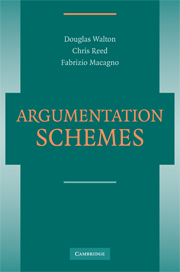Book contents
- Frontmatter
- Contents
- Acknowledgments
- Introduction
- 1 Basic Tools in the State of the Art
- 2 Schemes for Argument from Analogy, Classification, and Precedent
- 3 Knowledge-Related, Practical, and Other Schemes
- 4 Arguments from Generally Accepted Opinions, Commitment, and Character
- 5 Causal Argumentation Schemes
- 6 Schemes and Enthymemes
- 7 Attack, Rebuttal, and Refutation
- 8 The History of Schemes
- 9 A User's Compendium of Schemes
- 10 Refining the Classification of Schemes
- 11 Formalizing Schemes
- 12 Schemes in Computer Systems
- Bibliography
- Index
11 - Formalizing Schemes
Published online by Cambridge University Press: 05 June 2012
- Frontmatter
- Contents
- Acknowledgments
- Introduction
- 1 Basic Tools in the State of the Art
- 2 Schemes for Argument from Analogy, Classification, and Precedent
- 3 Knowledge-Related, Practical, and Other Schemes
- 4 Arguments from Generally Accepted Opinions, Commitment, and Character
- 5 Causal Argumentation Schemes
- 6 Schemes and Enthymemes
- 7 Attack, Rebuttal, and Refutation
- 8 The History of Schemes
- 9 A User's Compendium of Schemes
- 10 Refining the Classification of Schemes
- 11 Formalizing Schemes
- 12 Schemes in Computer Systems
- Bibliography
- Index
Summary
The goal of this chapter is to show how to formalize the schemes by expressing each scheme as a formal inference structure in a way comparable to forms of inference we all are already familiar with in deductive logic, and to some extent in inductive reasoning. Although deductive and inductive forms of argument can be included as argumentation schemes, the most difficult part of this project is the formalization of the defeasible schemes. The defeasible schemes listed in the compendium represent the most common forms of reasoning not only in everyday discourse, but also in special contexts of use like legal and scientific reasoning. The defeasible schemes presented in the compendium look to have a rough formal structure, but there is a wide variety of them, utilizing many different kinds of variables and constants. Before the schemes can be formalized, further clarifications need to be made (Verheij, 2003).
THE DEFEASIBLE MODUS PONENS FORM OF SCHEMES
In order to be useful in logic, artificial intelligence, and related scientific fields, schemes must be formalized, meaning that they have to be codified in some precise way so that the coder (whether machine or human) can recognize a particular argument as fitting a scheme and then use it to derive conclusions from the given set of premises based on that identification. Once an argument is recognized as fitting a scheme, an argument markup, utilizing an argument diagram, can reconstruct the argument in a given case using the scheme as a template or pattern on which to frame the reconstruction.
- Type
- Chapter
- Information
- Argumentation Schemes , pp. 364 - 392Publisher: Cambridge University PressPrint publication year: 2008



